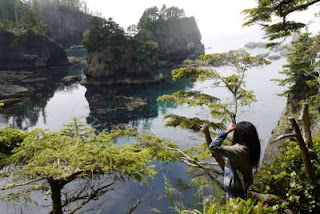
“He has made everything beautiful in its time. He has also set eternity in the hearts of men” (Ecclesiastes 3:11 NIV).
Hank and I walked from the dimness of the Makah Cultural and Research Center museum at Neah Bay into bright summer sunshine. I love the feeling of history that pervades that place. It’s not at all like most USA small-town historical museums. No stagecoaches, no old-time wash machines, no photos of early-day street scenes. The history here goes way back, thousands of years before the European arrival on New World shores.
Five hundred years ago, a mudslide buried the Makah village at nearby Ozette, perfectly preserving everyday household articles, tools, basketry, ceremonial objects...all made of ordinarily perishable fiber, bone, and wood. Archaeologists and modern-day Makahs rescued these artifacts and used them to reconstruct parts of the ancient culture lost with the coming of the white man. They built the museum to share that culture with visitors and to teach it to their young people. The past, the present, and the future come together here.
We’d observed how the Makahs adapted to the changing natural cycles: gathering roots, berries, shellfish and other necessities; fishing; seal hunting; whaling. Their long houses built of cedar planks were well-suited to the cool, rainy climate. We marveled at their ingenuity—from constructing end-to-end whalebone and driftwood drains to carry rainwater away from their houses—right down to the tiny torches that seal hunters wore on their headbands while searching dark sea-caves for their quarry.
We drove through the town of Neah Bay to Cape Flattery—the westernmost headland of the contiguous United States—to one of our favorite places: a three-quarter mile trail leading through fir and cedar forest to the point of the Cape.
It’s a popular trail. We lingered while other hikers passed us on the new boardwalk, noting scars on cedars where Indian women had once harvested bark for making mats, baskets, hats, capes, and other articles of clothing. We imagined them picking huckleberries and salmonberries, thimbleberries, and salal berries like those growing in the understory beside the trail.
In we
 ather less calm than this, visitors hear waves crashing into the cliffs long before they see the ocean. On this day, we heard mostly the cries of seabirds echoing through the forest. Then the point narrowed. From either side of the trail we looked down into blue-green waters reflecting the sedimentary bluffs and sea stacks.* Arching caverns yawned deep into the bluffs. The scene looked like it hadn’t changed for an eternity, but a sign posted along the trail informed us that on a stormy day, we would feel waves crashing into those caves, shaking the whole point. Someday, who knows how far into the future, the roofs of the caves will collapse and the point we stood on will erode into the sea.
ather less calm than this, visitors hear waves crashing into the cliffs long before they see the ocean. On this day, we heard mostly the cries of seabirds echoing through the forest. Then the point narrowed. From either side of the trail we looked down into blue-green waters reflecting the sedimentary bluffs and sea stacks.* Arching caverns yawned deep into the bluffs. The scene looked like it hadn’t changed for an eternity, but a sign posted along the trail informed us that on a stormy day, we would feel waves crashing into those caves, shaking the whole point. Someday, who knows how far into the future, the roofs of the caves will collapse and the point we stood on will erode into the sea.
Fog had closed in by the time we reached the final viewpoint, hiding nearby Tatoosh Island from view. In summer, Makah families once camped on the island to dry their winter’s fish supply. Whalers set out in sea-going canoes to intercept their migrating prey. Later, the Coast Guard used the island. An inoperative lighthouse still stands.
On my first-ever visit to this magical place, I peered into the dark caves where bold hunters once swam in pursuit of seals, imagining them armed only with spears and the tiny torch flames on their headbands. Even from above, the water looked frigid.
Suddenly, a pale shape rose from the nearby depths. My heart nearly stopped as the apparition grew larger and larger. A big, sleek head popped up, followed by huge shoulders and flippers. Two-thirds of the creature was still underwater--the biggest sea lion I’d ever seen. Two dark, inscrutable eyes peered into mine. The creature blinked and sank straight down and out of sight like a spirit from the deep.
Today, the waters are full of orange hemispheres trailing whitish tentacles. Squid? “No,” said the Makah ranger, a woman, stationed at the overlook to answer visitors’ questions. “They’re migrating jellyfish. It happens about this time every year.” She didn’t know where they came from or where the current would take them. But as far as she knew, they always came and always would come.
That would be nice. But history—ours, the Makahs’, that of the ocean creatures—tells us that nothing lasts forever. Yet, God has set eternity in the heart of man, and he has made everything beautiful in its time. He has done that to turn our hearts to our Maker. I think that’s what I feel most powerfully when I walk the Cape Flattery trail.
* Columns of rock cut away from the main mass of rock by wave erosion and standing alone, often crowned with their own small forests.

No comments:
Post a Comment
Comments? Click here.